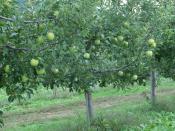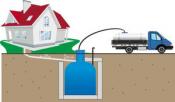Search
Login
Recommended
Work in the garden. Fertilizing fruit trees and shrubs in summer
The productivity of fruit crops and their stable growth are significantly affected by timely top dressing, which must be carried out regularly and taking into account the growing season of plants.
Fertilizing fruit shrubs and trees in the summer is an integral part of competent garden care. When organizing feeding the garden, it is important to take into account the peculiarities of the development of the root system, shoots and the timing of fruiting of trees and shrubs. Such an approach will protect plants from certain diseases, increase frost resistance and provide a stable harvest of the current and next year.
Content
- The importance of summer dressing for the development of fruit shrubs and trees
- Types of fertilizers and their impact on the growth of fruit trees and shrubs video
- Organization of feeding fruit trees
- Organization of fertilizing fruit shrubs video
- Foliar top dressing video
The importance of summer dressing for the development of fruit shrubs and trees
The fruiting and growth of fruit trees and shrubs directly depends on the supply of nutrients in the root system and aboveground organs of plants. It is clear that the necessary useful elements for the normal development of shrubs and trees are constantly being consumed and they need to be replenished on time, feeding plants with organic and mineral fertilizers.

Spring blossoming of the buds of fruit trees, active growth of shoots, roots and flowering of the garden occurs mainly due to nutrients accumulated over the previous summer and autumn. Therefore, it is necessary to lay the foundation for the future harvest in advance, namely in the summer.

In addition, the most active assimilation of nutrients by fruit and berry plants occurs in spring and with the onset of summer, therefore it is at this time that it is important to support and feed trees and shrubs. However, one must be careful to prevent an overabundance of mineral and organic fertilizers, this can have a detrimental effect on plants, and even a destructive effect on young shrubs and trees.
Types of fertilizers and their impact on the growth of fruit trees and shrubs
Fruit and berry plants in the garden can be fed with organic and mineral fertilizers.
Organic fertilizers include:
- compost;
- manure;
- sideral cultures;
- slurry.
Compost is a fertilizer consisting of rotted waste, plant waste.

Uncomposed compost must not be used; there is a possibility that viable weed seeds remain in it.
Manure is considered a full-fledged organic fertilizer, enriching the soil with useful elements and improving its thermal regime, air and water permeability.
When using manure, one must pay attention to its condition; rotted manure is a dark brown loose earthy mass. The most effective fertilizing effect on fruit and berry plants is exerted by poultry manure (pork manure has a low nutrient content).
Composting the soil improves the use and absorption of mineral fertilizers.
In gardening, the following mineral fertilizers are used:
- nitrogen;
- phosphoric;
- calcium;
- potash;
- micronutrient fertilizers.
Nitrogen fertilizers (urea, ammonium sulfate, ammonium nitrate) show the best results on sandy soils, and chernozems are least of all in need of replenishment of nitrogen reserves. Nitrogen-containing fertilizing accelerates the growth of trees, shrubs, and is involved in the formation of fruits.

Nitrogen fertilizers are not fixed in the soil and if they were not used by the plant, then they are simply washed out of the soil over time. Therefore, nitrogen must be added regularly several times during the year. It should be remembered that in order to obtain a visible effect from fertilizers, the soil must be slightly moist when fertilizing is applied so that ammonia does not evaporate.
Phosphate fertilizers (superphosphate, double superphosphate, bone and phosphorite flour) in gardening are usually used in granular form. Phosphorus-based top dressing is applied deep into the soil, since phosphorus fertilizers are firmly fixed in the ground.
The effectiveness of phosphate fertilizers largely depends on their solubility. Superphosphate is a fast-acting fertilizer, and slowly soluble phosphorus fertilizers should be thoroughly mixed with the soil.
Top dressing in the summer of the orchard with phosphorus fertilizers is usually not done, but plants are fertilized in the fall.

Fertilizing fruit plants with potassium fertilizers (potassium sulfate) helps plants synthesize sugar, improve winter hardiness, drought tolerance and increase resistance to fungal diseases. Potassium accumulates well in chernozems, and is weaker on sandy and peaty soils.

Wood ash has a high potassium content and is often used by gardeners to feed fruit trees and shrubs.
Important for the proper development of plants and high productivity is the timely introduction of micronutrients, which contain the whole complex of necessary trace elements, such as: manganese, copper, iron, boron, zinc, sulfur, molybdenum.
Organization of feeding fruit trees
how to determine the amount of fertilizer for the orchard
You can calculate the amount of fertilizer needed per fruit tree in the following way:
- One should be added to the diameter of the tree’s crown and multiplied by 3.14. The result of the calculation shows the soil area for fertilizing.
- The calculated area must be multiplied by the necessary for 1 square. m. dose of fertilizer.
When organizing the feeding of fruit trees, the following points should be considered:
- the intensity of the irrigation regime affects the amount of fertilizer applied; plentiful irrigation requires several large doses of nutrients;

- if it is planned to carry out a substantial pruning of trees, then the amount of fertilizer should be increased for better growth of young shoots;
- liquid fertilizers should be applied around shrubs and trees, going beyond the crown projection by about half a meter;
- if the soil is regularly fertilized with ash, then there is no need for micronutrient fertilizing;
- it is necessary to reduce the acidity of the soil (optimal acidity of 5.5-6.5 pH), liming the soil, add lime plaster or powdered slaked lime to the soil;

- to feed young plants, less concentrated preparations should be used;
- while applying mineral and organic fertilizers, their rate should be halved.
summer top dressing of pome and stone fruit trees
Summer top dressing of fruit trees is necessary to activate the activity of the root system, as well as to strengthen its nutrition. The enhanced ability to absorb nutrients from the roots contributes to the laying of buds in the summer, when the fruits weigh on the trees.
It should be noted that pome fruit trees (pear, apple) need higher doses of organic and mineral fertilizers than stone fruits (cherries, apricots, cherries, peaches).

To feed apples and pears (9-10 years of age), you can adhere to the following fertilizer consumption per square meter per month (June, July, August):
- potassium salt 3 g;
- superphosphate 5 g;
- montan saltpeter 6 g.
Late top dressing in August for adult plants will not bring harm, unlike young trees, since all nutrients will be involved in laying the crop for next year, and not for the active growth of young shoots.
Stone fruit trees must be fed three times during the growing season: the first before flowering (in spring), the second during the fruit filling season, and the third after harvesting.

Cherry top dressing in summer can be organized as follows:
- During the fruit filling period, the tree should be poured with a solution of Berry Giant (300 grams per bucket of water) with the addition of two tablespoons of urea. The berry giant can be replaced with three tablespoons of nitrophoska.
- After harvesting, the tree should be fertilized with this solution: three tablespoons of superphosphate and two tablespoons of potassium sulfate in a bucket of water.
Conducting such fertilizing will help trees to winter well and protect them from many diseases and pests.
Organization of fertilizing fruit shrubs
In summer, berry shrubs need intensive top dressing. For the season, it is advisable to carry out four dressings:
- the first during flowering (mid-May);
- the second during the period of intensive growth of shoots (early June);
- the third at the time of formation of the ovary, filling berries (June-July);
- fourth after harvest.
Top dressing of berry bushes should be carried out after watering or rain.
It is advisable to top up raspberries in early summer with mineral fertilizers (liquid): 10 grams of potassium chloride, 40 grams of superphosphate, 20 grams of urea per bucket of water (consumption for 6-7 bushes). After fertilizing, the soil under the plant must be loosened.

Once every three years, raspberries should be fed with organic fertilizers per 1 sq.m. 0.5-1 bucket of humus or manure.
Currant is very sensitive to top dressing. When organizing top dressing of a berry shrub, it is important to remember that currants react poorly to the chlorine content of fertilizers, so it is important to correctly calculate the dose of potash top dressing.

Topping up currants in summer can be done in the following steps:
- If in the autumn organic fertilizers were introduced under the currant, then the plant should be fed with nitrogen fertilizers (for 10 liters of water 35 grams of calcium nitrate, 15 grams of ammonium nitrate, 12 grams of urea). If organic fertilizers were not applied before winter, then in spring and summer, the bush should be fed with organic fertilizers (manure should be diluted in water and urea added). Such dressings should be done three times: the first in the spring before flowering, and each subsequent with an alternation of two weeks.
- To increase the content of vitamins in berries, to improve their taste and aroma, it is necessary to feed the prepared fertilizer mixtures: Berry, Ideal, Berry giant. During the summer, you can spend three dressings (the latter should be immediately after picking berries).
Gooseberries need higher doses of potash fertilizers than currants. Gooseberries must be fed in the first half of summer with nitrogen fertilizers (13-16 grams of dry active substance per 1 sq. M) with the addition of potassium and phosphorus (30 grams of superphosphate and 15 grams of potassium sulfate). If top dressing is carried out in dry weather, then dry fertilizers must be dissolved in water.
It is impossible to feed gooseberries with nitrogen fertilizers in the second half of summer, otherwise the young shoots of the plant will become brittle and susceptible to powdery mildew. In addition, such a shrub can not tolerate the harsh weather conditions of winter.
Foliar top dressing
As an additional feeding method in summer, foliar feeding of fruit trees and shrubs is often used. When foliar feeding (spraying) plants receive nutrients directly through the leaves.
For such top dressing, both organic and mineral fertilizers are used. Foliar top dressing with microfertilizers gives a good effect. Zinc increases the resistance of trees and shrubs to diseases, boron promotes active and abundant flowering, and manganese increases the yield and sugar content in fruits.

With foliar top dressing, it is necessary to use weak solutions of fertilizers, so as not to damage the leaf tissue. The concentration of urea for foliar top dressing in the summer should be no more than 1%, sulfate or potassium chloride 0.5-1%, superphosphate up to 5%.
Foliar top dressing of pears and apple trees can be carried out with a solution of zinc sulfate (0.2 g / l), borax (1 g / l) or manganese sulfate (0.2 g / l). If you combine all three trace elements at the same time, then the dose of each must be reduced by half.
After harvesting, the currant bush can be treated with a solution: 5 g of potassium permanganate, 10 g of copper sulfate, 2 g of boric acid per bucket of water. Spray currant bushes in the evening.

Foliar top dressing with potash and phosphoric (1-2%) fertilizers, as well as trace elements: manganese sulfate (0.1-0.5%) and boric acid (0.01-0.05%), are very useful for gooseberries.
In early summer and after harvesting, raspberries can be treated with zinc or manganese sulfate (5-10 g per 10 liters of water), copper sulfate (about 5 g per 10 liters of water) or molybdenum ammonium (1-3 g per bucket of water).
Timely top-dressing of trees and shrubs will allow you to annually get a high yield and enjoy the beautiful, well-groomed appearance of the orchard.





